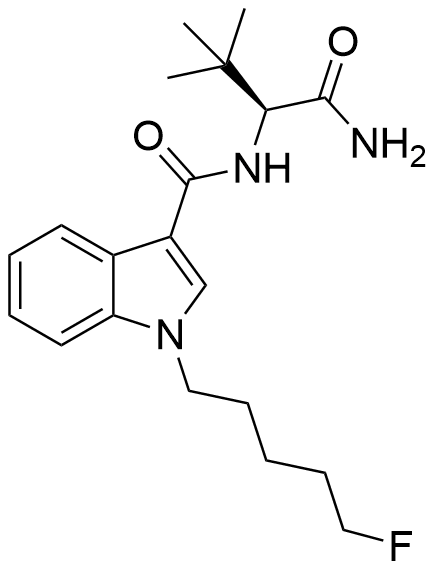Summary
5F-ADBICA, also referred to as 5F-ADB-PICA, is an indole-derived synthetic cannabinoid recognized for its agonistic solid activity at both CB1 and CB2 receptors, displaying remarkable EC50 values of 0.77 nM and 1.2 nM, respectively.
| Identifiers | |
|---|---|
| IUPAC name | |
| CAS Number | 1801338-27-1 |
|---|---|
| PubChem CID | 118796421 |
| ChemSpider | 52085200 |
| UNII | U9H280G9O7 |
| Chemical and physical data | |
| Formula | C20H28FN3O2 |
| Molar mass | 361.461 g·mol−1 |

Legal Status
In China, 5F-ADBICA has been designated as a controlled substance since October 2015.
FAQ
1. What is 5F-ADBICA?
- 5F-ADBICA, also known as 5F-ADB-PICA, is an indole-based synthetic cannabinoid known for its agonistic activity at CB1 and CB2 receptors.
2. What does it mean that 5F-ADBICA is an indole-based synthetic cannabinoid?
- Being indole-based signifies that 5F-ADBICA shares a structural similarity with the indole ring, a common feature in synthetic cannabinoids.
3. How potent is 5F-ADBICA at the CB1 and CB2 receptors?
- 5F-ADBICA is a potent agonist at both CB1 and CB2 receptors. It has EC50 values of 0.77 nM at CB1 receptors and 1.2 nM at CB2 receptors, indicating its strong binding affinity for these cannabinoid receptors.
4. Is 5F-ADBICA legal to use or possess?
- The legal status of 5F-ADBICA varies by country and region. It is essential to be aware of the specific laws and regulations in your area regarding the use and possession of this substance.
5. What are the potential health risks associated with 5F-ADBICA?
- The use of synthetic cannabinoids like 5F-ADBICA can pose serious health risks, including unpredictable effects, addiction, and adverse reactions. Long-term results and safety profiles may not be well understood.
6. Can 5F-ADBICA be detected in drug tests?
- The ability to detect 5F-ADBICA in drug tests may depend on the specific tests used and their sensitivity to this substance.
7. Where can I find more information about 5F-ADBICA and its effects?
- For comprehensive information on 5F-ADBICA, its properties, legal status, potential health risks, and guidelines for responsible use, consult reputable sources such as government health agencies, medical professionals, and substance abuse organizations.
References
- In a September 2015 study by Banister SD, Moir M, Stuart J, and their colleagues, the pharmacology of synthetic cannabinoid designer drugs was explored. The research covered a range of compounds, including AB-FUBINACA, ADB-FUBINACA, AB-PINACA, ADB-PINACA, 5F-AB-PINACA, 5F-ADB-PINACA, ADBICA, and 5F-ADBICA. This study was published in ACS Chemical Neuroscience, Volume 6, Issue 9, spanning pages 1546 to 1559. You can access the study via doi:10.1021/acschemneuro.5b00112. The PMID is 26134475.
- Information about 5F-ADBICA can be found through the Southern Association of Forensic Scientists, retrieved on July 21, 2015.
- On September 27, 2015, the China Food and Drug Administration issued a notice in Chinese titled “关于印发《非药用类麻醉药品和精神药品列管办法》的通知,” which translates to “Notice on Issuing the ‘Measures for the Supervision and Control of Non-Medicinal Narcotic Drugs and Psychotropic Drugs'” in English. This notice pertains to the regulation of certain substances.